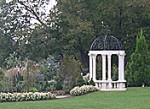 Many hot and sunny days have pushed the plants to grow and flower but some are looking floppier than in other years. This was a productive week of work as I planted most of my annuals and started many seeds and cuttings to use later in the summer when everything seems to bog down and look ratty due to the persistent heat and humidity.
Many hot and sunny days have pushed the plants to grow and flower but some are looking floppier than in other years. This was a productive week of work as I planted most of my annuals and started many seeds and cuttings to use later in the summer when everything seems to bog down and look ratty due to the persistent heat and humidity.
Hydrangeas all over the town are blooming. I have very little shade and this oak leaf hydrangea occupies some of it and actually needs more light.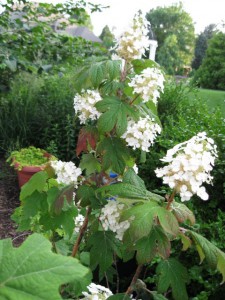
My shady areas are growing as the new trees we planted three years ago have taken off and produced modest canopies and so I bought two hydrangeas that have yet to be planted.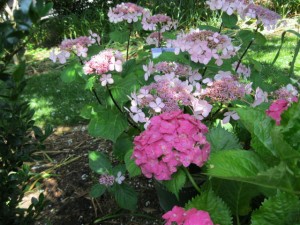
My other purchase was this ‘August Beauty’ gardenia. This one has 2½” flowers that look like the florist gardenias and have a wonderful fragrance. It is hardy in zones 7-9 so I will have to find a protected place for it, perhaps near a bench so I can enjoy it close up.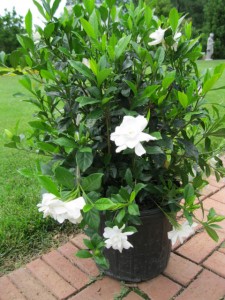
My red astilbes have open up. They grow in a very sunny area but have done well there, however, because of copious amount of water. The water was so excessive it killed the Kleims gardenia and the Daphne odora in the same area.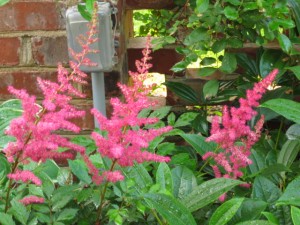
The bog garden boasts a single orchid spray growing in front of a Japanese iris that provides a nice backdrop for the delicate flowers.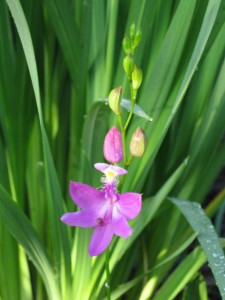
The daylily display has begun. I revamped the daylilly beds last year and now have over 50 cultivars, these being the first to bloom.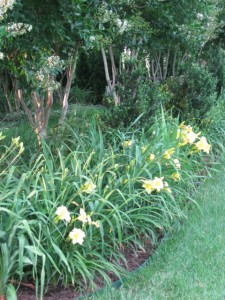
These yellow ones bloom about a week to ten days before any others in my garden, but at the same time as the ones along the roadside. They were a hand me down plant so I have no idea what kind they are but they bloom well and are well behaved.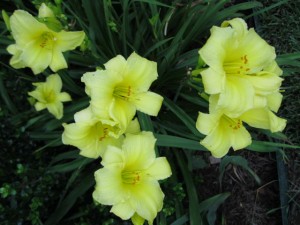
The crepe myrtles above and behind them burst into bloom with their white clusters of flowers right after the yellow daylilies appeared.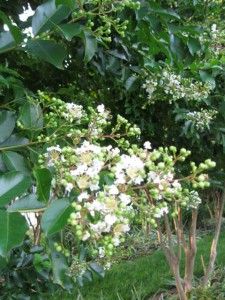
The stewartia trees are also blooming. They are great trees, offereing something in every season. They are colorful in the fall, have interesting and beautiful bark all winter into spring, and in summer they produce flowers.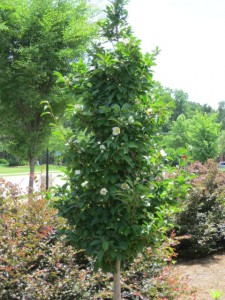
The flowers are fairly large and are thought to resemble camellias, hence their Latin species name pseudocamellia.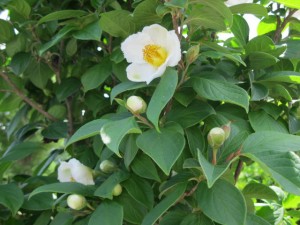
In the formal garden the coneflowers are making their debut next to “Lovely Fairy’ rose. I have so many pink ones that I am going to have to start eliminating them.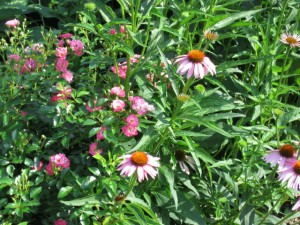
I bought ‘Magnus’ three years ago and always put the dead headed flowers on the ground so have many new plants that are of inferior bloom.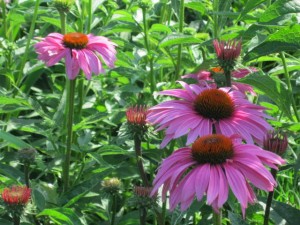
The white coneflowers are not as abundant or stocky as my other coneflowers. I throw the dead headed flowers back into the garden as I do with the pink ones but so far have not generated any new plants. Here they are growing in our bird area with grasses, golden rod and brown-eyed Susans.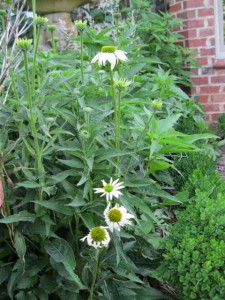
This orange-yellow coneflower is much shorter than the pin or white ones and has a slightly different growth habit. It is a great addition to the hot border.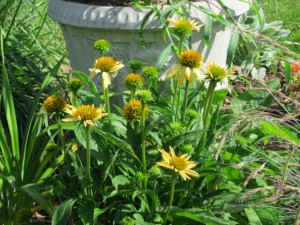
The hot border got a lot hotter this week.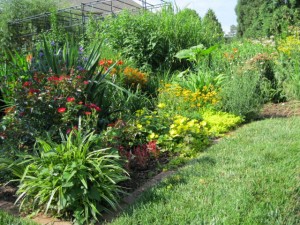
The Asiatic lily ‘Grand Paradiso’ is a knock out with the orange pokers and butterfly weed.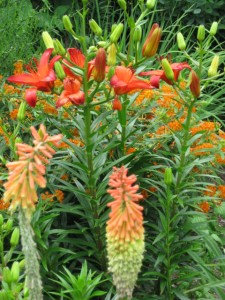
The flowers are large and intense scarlet-red.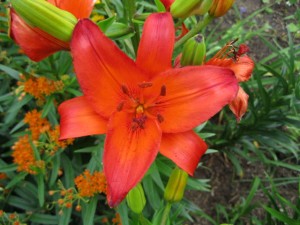
The flowers of the species lily, Lilium davidii, are rich-orange with abundant dark spots and hang demurely from the tall stems, with their petals recurved.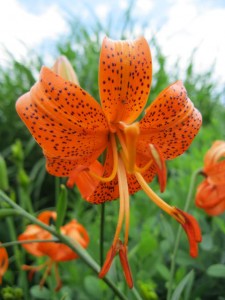
In the white border the phlox ‘David’ is displaying its billowing blooms with Cornus ‘Elegantissima’ in the background and ‘White Fairy’ in the foreground..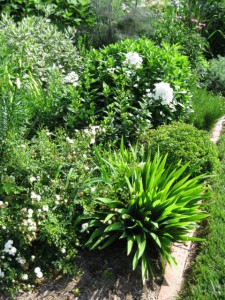
‘David’ is one of the more mildew resistant varieties, an important consideration in my hot and humid climate.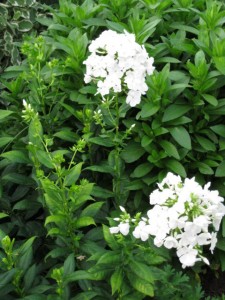
The gooseneck lysamachia has attained that ‘look’ I love so much. Here it appears in front of one plant of cleome that is a volunteer from last year’s planting.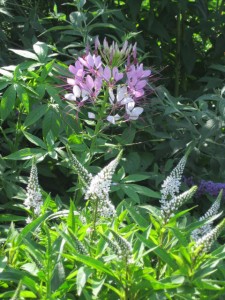
At its feet, is stokesia. This plant is very floppy this year and can hardly been seen amid the other plants.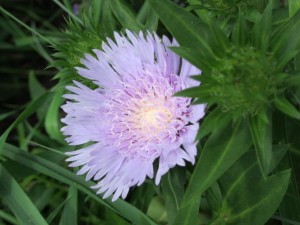
I cut back the lavender this year hoping it would bush out. It seems to have survived but is not back to normal and probably will die out. I love the look and smell of the lavender but have found that it only lasts in my zone 7 garden for 3-4 years before it succumbs.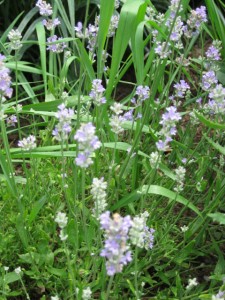
The hollyhock are doing better as the days go on. We spray it against rust when we spray our roses and so far we have seen no rust on them. These plants were all started from seed last year.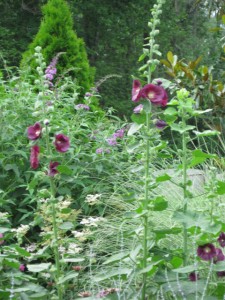
Since hollyhock reseed, I probably don’t have to start new ones but since I had seed left over from last year I decided to give them a try. Here they are…not a lot of them but I’ll put the ones I get in the garden this fall.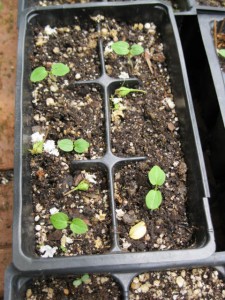
I also started some cardinal vine seeds several weeks ago and they are almost ready to plant in the pots with the iron frames made by the head gardener.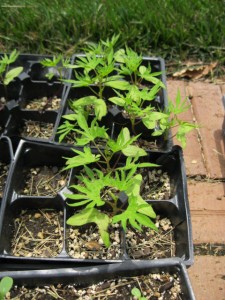
I sowed basil seed directly into the pot outside my kitchen door and it is doing well. I have a terrible fault of not being able to thin the seedlings as I should so none of them does as well as they should.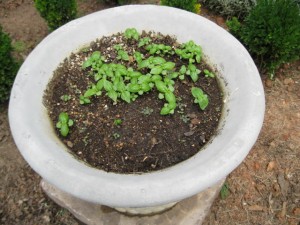
This was the week of tea for the roses. I put 12 cups of alfalfa pellets in a 32 gallon garbage can of water for 5 days, stirring it everyday with a sick.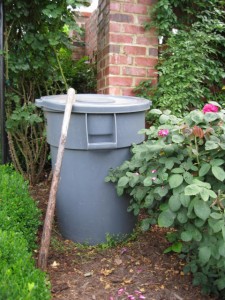
Scum develops on the surface that has a considerable barnyard smell.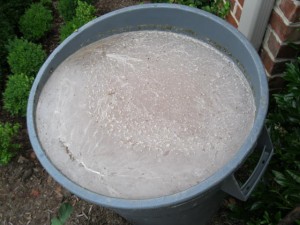
When you stir it, the surface looks even worse.
Each rose plant gets a gallon and loves it!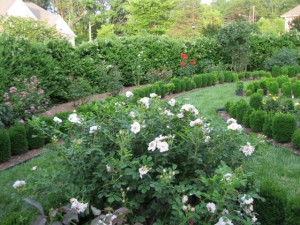
The vegetable garden was also the site of much activity. The head gardener made tomato cages from the mesh used in reinforced concrete. The white things in each cage are gallon milk cartons with tops cut off, placed there so I can water and fertilize each plant individually throughout the season.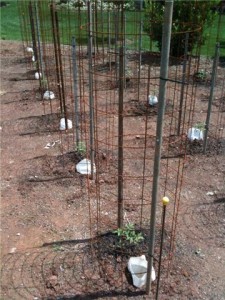
Lengths of mesh were cut and then fastened using the projecting wires of the mesh. Plastic wire ties were used to attach the cages to upright 3/4″ pipe pounded into the ground so that the cages would not topple over as the plants grew on them.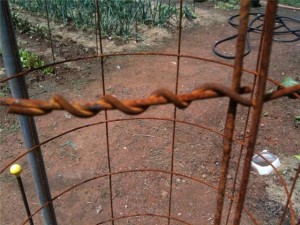
The mesh was also set up as a support for pole beans.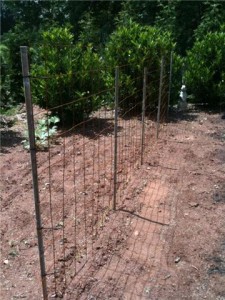
The horseradish just grows on its own as I keep a watchful eye on it to make sure it does not take over more room than it deserves. These really belong to the head gardener who appreciates their robust nature more than I do.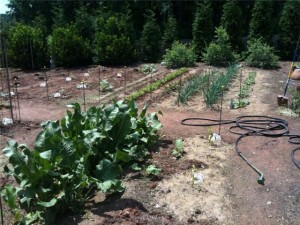
A check on the blueberries reveals potential but still no ripe berries. So far the birds and other wildlife have not bothered the bushes so we are still hoping for a good crop.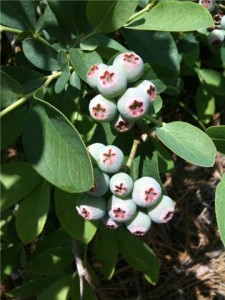
Meanwhile, the market is selling blueberries for $1.00/pint. I will try to holdout for my own.

That is a lovely orchid in your bog garden! Is it a native?
Jackie,e
I don’t know if it is native or not. I bought it from a vendor at the Greensboro Farmer’s Market two years ago. He is there again this year with the same plants (and reasonable prices). I will try to find out more about it as it actually sems to like our bog and has come back for two years, growing slightly each year. It is certainly not vigorous and the foliage is even less conspicuous than the flower but it is quite striking when in bloom.
Karen